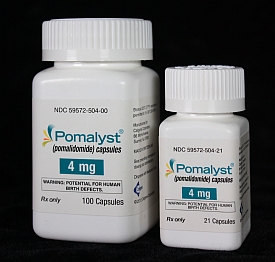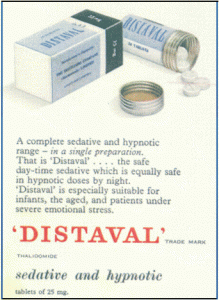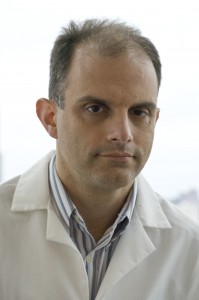 Thalidomide has its own fascinating history. Originally developed by Chemie Grünenthal GmbH in the 1950s, it was the result of a search for an anti-anxiety drug to compete with Valium, and was approved for use in Europe as a sleep aid and depression treatment. Eventually, doctors found it useful for treating nausea, and started prescribing it off-label to pregnant women with morning sickness.
Thalidomide has its own fascinating history. Originally developed by Chemie Grünenthal GmbH in the 1950s, it was the result of a search for an anti-anxiety drug to compete with Valium, and was approved for use in Europe as a sleep aid and depression treatment. Eventually, doctors found it useful for treating nausea, and started prescribing it off-label to pregnant women with morning sickness.
The results were disastrous. Thalidomide turned out to be a teratogen, causing severe birth defects. It was quickly banned in European countries, though it still was used in rare situations as a treatment for leprosy.
Thalidomide and angiogenesis
Fast forward to the early 1990’s. D’Amato was a young researcher in the lab of the late Judah Folkman, MD, father of angiogenesis research and founder of what’s now the Vascular Biology Program at Boston Children’s Hospital. Folkman was working to develop drugs that would inhibit different cancers by blocking angiogenesis, preventing the cancer from developing its own blood supply.
When D’Amato joined the lab, he proposed searching for anti-angiogenic drugs by looking for existing drugs whose reported side effects were consistent with inhibited growth of blood vessels—such as inhibition of wound healing, interruption of menstrual cycles and disruption of fetal development.
This search led D’Amato to examine five drugs, including thalidomide. His experiments found that thalidomide has dramatic anti-angiogenic activity, which explained the notorious birth defects: thalidomide stunts blood vessel growth in the limbs of the developing fetus.
Further experiments comparing teratogenic and non-teratogenic thalidomide derivatives revealed that the more teratogenic the drug, the more potent its anti-angiogenic activity. For example, deoxy-thalidomide (called EM-12) is a more powerful teratogen and more anti-angiogenic than thalidomide itself.
D’Amato went on to show that thalidomide could inhibit tumor growth by preventing tumors from recruiting new blood vessels. He further showed that anti-inflammatory drugs like sulindac or dexamethasone could enhance thalidomide’s anti-angiogenic and antitumor activity. The stage was now set.
Thalidomide reborn
In his own work, Folkman had discovered that an anti-angiogenic drug called TNP-470 was active against multiple cancers in animal models, including blood-borne cancers such as leukemia. He had become interested in blood-borne cancers after observing high levels of angiogenic growth factors such as fibroblast growth factor in these patients’ blood and urine.
One day Folkman received a call from a patient’s wife. Her husband was dying from multiple myeloma, a fatal blood-borne cancer. Folkman wanted to try TNP-470, but, in a twist of fate, was unable to secure any outside the ongoing clinical trial. D’Amato suggested that they try thalidomide.Folkman explained the research data to the patient’s doctor, Bart Barlogie, MD, and cited a paper showing that angiogenesis in the bone marrow correlated with myeloma severity. After several calls, he convinced Barlogie to ask Celgene—the company that at the time was approved to sell thalidomide for leprosy—to provide the drug for this patient.
That request led to a three-patient clinical trial, in which two of the three patients had a dramatic response to the drug. Eventually, thalidomide combined with dexamethasone would become a first-line, FDA-approved therapy for multiple myeloma.
The next generation of thalidomide analogs
Even though D’Amato believed that thalidomide was a good cancer drug, he wanted to make a stronger version. He realized that by chemically tweaking thalidomide—removing an oxygen here, replacing amino groups there, and so on—he might be able to develop analogs optimized for anti-angiogenic activity. In his original thalidomide paper, D’Amato had reported that deoxy-thalidomide (EM-12) was a more potent angiogenesis inhibitor.
Searching for ever more powerful versions of thalidomide, he added an amino side group, based on a 1966 report that amino-thalidomide was a teratogen—and found that this increased the anti-angiogenic and anti-myeloma activity. Celgene took the first of these amino-substituted thalidomide analogs, amino-EM-12, into clinical trials for myeloma. Approved by the FDA in late 2005 under the name Revlimid®, it is the sixth-best-selling cancer drug in the United States.
But the most potent and active anti-angiogenesis analog was amino-thalidomide, later called pomalidomide. When screened in D’Amato’s cancer assays, it was good at inhibiting cancers such as lung cancer, but caused myeloma tumors to shrink away to nothing. The added amino side group didn’t just increase thalidomide’s anti-angiogenic activity: it also directly suppressed myeloma cell proliferation. Thalidomide now had two powerful mechanisms of action.
In 2001, a company called EntreMed began a Phase I trial with amino-thalidomide in the United States, and Celgene initiated larger trials in 2005. The drug was tested in multiple myeloma patients who had stopped responding to Revlimid and was given together with dexamethasone. After a great response rate—30 percent—in a Phase II trial, the FDA approved the drug on Feb. 8 under the name Pomalyst. (And yes, it is contraindicated in pregnancy.)
“It’s been a very long, exciting journey,” says D’Amato. “The approval of Pomalyst is like seeing your child graduate from college. It is exciting to see patients finally get to realize the benefits of all of the hard work.”









